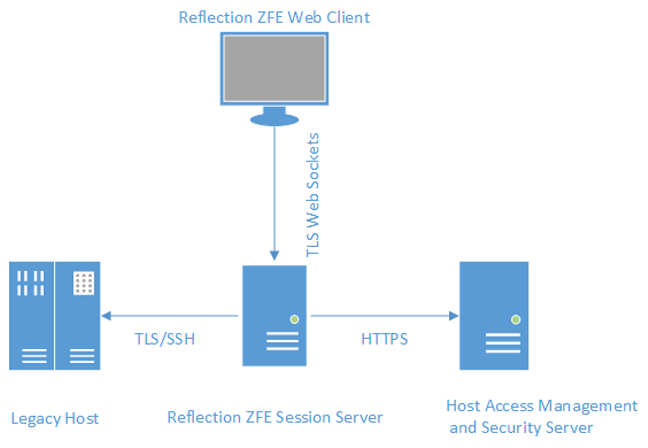2.1 How does it work?

It is a simple solution. Reflection ZFE drives down IT costs. You have eliminated the need to touch the desktop.
2.1.1 Reflection ZFE components
Familiarize yourself with how ZFE uses the three components it is composed of:
-
Host Access Management and Security Server
The Host Access Management and Security Server (MSS) provides an Administrative Console, a web-based centralized location where you can add, edit, and delete terminal sessions. MSS is part of the broader Micro Focus story and is compatible with other Micro Focus products.
Things to keep in mind when preparing to install MSS:

Host Access Management and Security Server (MSS) is used for session management: MSS is installed with ZFE in a typical installation, however, you can use an existing MSS installation if that works better for you. The install program will install MSS, the ZFE session server, and documentation to a single machine. Different components can reside on different machines. It is important that you install compatible versions of both products.

When you install ZFE you will be asked for the user name and password for the MSS machine used by ZFE. It is a good idea to have those credentials in hand before you start installation.

To use an already installed or remote MSS that has not been activated for use with ZFE, you will need to provide an activation file. You can read all about MSS activation files and learn the activation process in the Host Access Management and Security Server Installation Guide.You can, if necessary, activate the product in Administrative Console >Configure Settings >Product Activation.
-
Session Server
The session server is an NT service or UNIX daemon that provides the engine that runs host sessions. Multiple session servers can serve up tens of thousands of sessions and provide efficient and rapid access to your host data.
-
Web Client
The web client is the web-based terminal emulator where your users can easily access authorized sessions from any platform and from any location.
The Web client provides macros, keyboard and color mapping, on-screen keyboard, copy/paste functionality, host-initiated screen updates, and file transfer capabilities.
Understanding activation files
Activation files (activation.jaw) are used to enable product functionality. For example, the ZFE install package contains the needed activation file to enable communication between ZFE and MSS and is typically activated as part of the install process. Activation files are downloaded from the Micro Focus download site and are specific for the different editions and platforms supported by ZFE. To work in a production environment, activation is required.
HINT:Remember if activation was not part of the installation, you need to open the Administrative Console and complete the activation process (Configure Settings > Product Activation). See Upgrading from previous versions for information on handling activation files when you upgrade.
2.1.2 Browser and operating system support
Reflection ZFE is a 64-bit product and supports Google Chrome, Mozilla Firefox, and Microsoft Internet Explorer and Edge browsers. A complete list of supported platforms and other installation requirements is available in the Installation Guide.
2.1.3 Security considerations
When you open up your legacy hosts to users outside the corporate firewall - business partners, remote users, mobile sales personnel, and others - you need to shield your information from known security threats. With Reflection ZFE, you can provide secure web-to-host access to all your users, whether they’re around the corner or around the world. Reflection ZFE, along with the MSS, provides HTTPS connections and a variety of authorization and authentication options.
Reflection ZFE supports the TLS and SSH protocols to protect mission-critical data. To secure your passwords and other sensitive data, use the HTTPS protocol, which provides TLS encryption. Supported cipher suites include AES128, 168-bit Triple DES, and other strong ciphers, ensuring confidentiality and integrity of data over the Internet and other insecure networks.
Reflection ZFE can be connected securely to the browser, the host, and the management server. See Making Secure Connections for information on securing those connections.